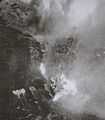Japanese amphibious assault ship Shinshū Maru
 | |
| Career (Japan) | |
|---|---|
| Name: | Shinshu Maru |
| Laid down: | 8 April 1933 |
| Launched: | 14 March 1934 |
| Commissioned: | 15 November 1934 |
| Fate: | Sunk 3 January 1945 |
| General characteristics | |
| Displacement: | 7,100 tons standard, 8,108 tons full |
| Length: | 144 meters |
| Beam: | 22 meters |
| Draft: | 4.2 meters |
| Speed: | 20.4 knots |
| Complement: | 2,000 |
| Armament: | 4 × 75 mm Type 88, 4 × 20 mm AA |
| Aircraft carried: | 6 × Nakajima Army Type 91 Fighters 6 × Mitsubishi Ki-30 Bombers |
| Aviation facilities: | hangar and catapult; no flight deck |
Shinshu Maru (神州丸) was a ship of the Japanese Imperial Army during World War II. She was the world's first landing craft carrier ship to be designed as such, and a pioneer of modern-day amphibious assault ships. During some of her operations, she was known to have used at least two cover names, Fuso Maru, and Ryujo Maru.
At least one source claims that the Shinshū Maru was one of the ships sunk by friendly fire at the Battle of Sunda Strait and then salvaged & returned to service.
Design features
Shinshu Maru was a significant advance in amphibious warfare, having incorporated numerous innovative features, and as such she was shrouded in a veil of secrecy throughout her existence. She could carry 29 Daihatsu-class landing craft, 25 Shohatsu-class landing craft and 4 armoured gunboats, to be launched from a floodable well deck.
In addition, Shinshu Maru could carry landplanes in a hangar within her superstructure; these aircraft could be launched by catapult to support amphibious assaults, but could not return to the ship, and must (hopefully) land on captured airfields instead.
These concepts pioneered by Shinshu Maru persist to the current day, in the U.S. Navy's LHA and LHD amphibious assault ships.
Fate
On 3 January 1945, while returning to Takao after a supply mission to Leyte Island, Shinshu Maru was heavily damaged by a US air attack; after the ship was abandoned she was sunk by the USS Aspro.
Photos
References
- Murray, Williamson and Millett, Alan R. Military Innovation in the Interwar Period. Cambridge: Cambridge University Press, 1996. ISBN 0-521-55241-9.
External links
- Landing Craft Carrier "Shinshu Maru"
- "A Japanese Warship Question"—Axis History Forum
See also
- Dock landing ship
- 海上機動旅団(Sea Landing Brigades) - Japanese Wikipedia article [Not translated]
- Japanese Special Naval Landing Forces - Part of the Land Forces of the Imperial Japanese Navy
